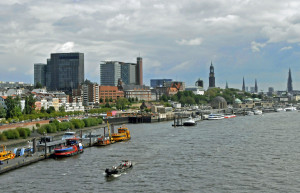
Port of Hamburg, Germany (Photo by Don Knebel)
Hamburg, the second largest city in Germany, was founded by Charlemagne in 808 along the Elbe River about 63 miles upstream from the North Sea. Hamburg became a tax free city in 1189 and its large port became one of the most important in Europe. In 1241, Hamburg joined with Lübeck and other trading cities to form the Hanseatic League. Until the unification of Germany in 1871, Hamburg was an independent city-state and is now a state all by itself, with a population of about 1.8 million. Its massive city hall, with 647 rooms, is the home of one of Germany’s 16 state parliaments.
Like other port cities, Hamburg became famous for its ladies of the night, who plied their trade along the Reeperbahn, sometimes called Germany’s “most sinful mile.” Until it closed in the 1980s, the Reeperbahn featured a six-story brothel, the largest in Europe. During the early 1960s, the Beatles, then unknown to the world, played in the clubs along the Reeperbahn and John Lennon once said, “I might have been born in Liverpool – but I grew up in Hamburg.” Beatles-Platz, a circular plaza near the Reeperbahn paved to look like a vinyl record, honors the Beatles’ days in Hamburg.
Many Germans coming to the United States in the nineteenth century left from Hamburg. In the New World they recreated the “Hamburg steaks,” made from ground beef, they remembered from home. Eventually, supposedly in connection with the 1904 St. Louis World’s Fair, someone put Hamburg steaks between pieces of bread and the “hamburger” was born.
Comments are closed.